[ad_1]
The original St. Peter’s Church on Barclay Street in New York City was the first Catholic church built in the city and state of New York. The church was built in 1786 for Irish immigrants and surprisingly the bell that had called them to prayer since 1806 still survives.
There are now plans to display the bell inside today’s St. Peter’s Church, a chance to connect today’s devotees with their ancestors.
It is known that in the early 19th century, County Cork-born priest John Power was a familiar sight in New York rowing the East River to say mass before the Brooklyn Bridge was built. Trained at St Patrick’s College, Maynooth, that major seminary of Irish Catholicism, Power ministered at St Peter’s Church on Barclay Street which was built in 1786 and later destroyed when part of the roof collapsed in 1836. He probably got massive mass bell funding.
Today, nothing remains of this church, except the bell which, for more than thirty years, called the Catholics of this region to prayer. The bell contains the names of Reverend William O’Brien and Reverend Matthew O’Brien, pastors of the church, Thomas Stoughton, John Sullivan, Michael Roth, Francis Cooper, John Byrne, Andrew Morris and Cornelius Heeney, benefactors of the church and bell.
The current Saint-Pierre church and the original Saint-Pierre church. Danny leavy
Carried out under the direction of Charles Sherry in Nantes on June 30, 1806, it is remarkable that the bell has survived given the many vicissitudes that the building has undergone. Nestled in the attic of the new Saint-Pierre, built after the disaster of 1836, the bell has remained there ever since. That was until Danny Leavy, a resident director in New York City, began researching the career of one of the church’s benefactors.
Cornelius Heeney (1754-1848) was perhaps New York’s most successful Catholic in the first half of the 19th century.
Born in Ireland, he immigrated to the United States at the age of thirty and despite a shipwreck in the process, he amassed a considerable fortune, most of which he donated for religious and charitable purposes. Indeed, the Brooklyn Benevolent Society which he helped establish in 1845 still exists today and continues the work begun by Heeney. The inscription on the memorial to Heeney located in front of the New York State Supreme Court building in Montague and Court Streets gives an indication of this remarkable Irishman:
CORNELIUS HEENEY / 1754-1848 / IRISH IMMIGRANT, EXEMPLARY AMERICAN / CATHOLIC PATRIOT, PIONEER, PHILANTHROP, / STATEMAN, COMING INTO POVERTY, INCREASING BY / INDUSTRY, STILL SHARING IN GENELINS / AMEROSIS, DES ORVES FROM BROOKLY. / DEDICATED OCTOBER 27, 1977 / BROOKLYN BENEVOLENT SOCIETY / FOUNDED MAY 10, 1845
In researching the career of this remarkable Irishman, Leavy, who lived and worked in New York for almost 30 years, teamed up with Dr Ciarán Reilly, an Irish historian from Maynooth University, who is himself on the Heeney’s footsteps for almost fifteen years. They hope to write a book in the near future on Heeney’s life and times, and in so doing, draw attention to his history in the United States and Ireland.
Before that, however, plans were in place for the old bell of St. Peter to be removed from the attic and displayed to the public outside the church. According to Leavy, the bell remains an important part of Catholic history in New York and the United States as it was erected at a very difficult time for the Church in America. “It’s an incredible artifact of Irish Catholic history,†he says. This is something we want to make the Irish American community aware of. Jarlath Quinn who has been very helpful in this proposed project in recent months.
Almost twenty years ago, the roof of St. Peter’s Church was badly damaged on September 11 in the attack on the World Trade Center. Today, the repair area can still be seen on the roof of Saint-Pierre. As we come together on the 20th anniversary of September 11, it is hoped that the bell of St. Peter, which has survived wars, famine and depressions intact, could also be a symbol of both freedom. religion, tolerance and hope in America. “When that bell rang it brought everyone together in a simple prayer, it’s a powerful image in itself,†Levy said. “He even survived September 11. “

[ad_2]

